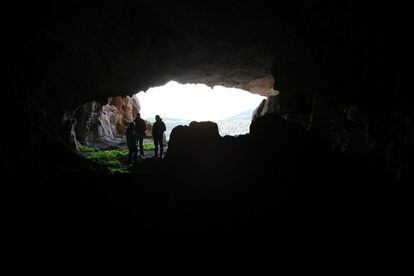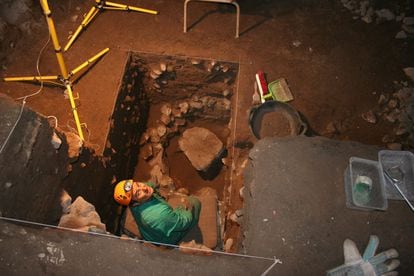Some specialists believe that what happened in Europe about 7,400 years ago was an encounter with an alien civilization. For thousands of centuries, Europeans have been nomadic hunters, the only known way of life on a vast, almost uninhabited continent. Until they met immigrants from Anatolia, in present-day Turkey, who brought with them agriculture, livestock, and a sedentary lifestyle. Their advance across the northern Mediterranean was very rapid – it lasted hardly a century – and it is believed that they traveled in small boats along the coast. It was a time of conflicts and coexistence. The farmers intermarried with the local population until they were assimilated; Although there were isolated clans of hunters loyal to their way of life for another 1,000 years. This is what is known as the Neolithic revolution that laid the foundations of civilization.
One of the biggest mysteries at this time is how this revolution came to Africa. One hypothesis is that it appeared spontaneously, with a second invention of crops, and another is that it appeared about 5,000 years ago, at the hands of shepherds and farmers from the Near East.
Now, a team led by scientists from the University of Burgos and Uppsala (Sweden) shows that the Neolithic arrived in this region in the same chronology as Europe, about 7,400 years ago. Their conclusions published in the journal natureIt is based on the analysis of teeth and bones discovered at four sites in Morocco, and comparing them with other existing sites.
The key is in the cave of Kaf under al-Ghar, on the northern coast of the strait on the Moroccan side, where human remains, seeds, and pottery shards decorated with mollusk shells have been found. They were practically identical to those found on the peninsula.

“It was like finding a Baroque cathedral in the middle of Aztec Mexico,” explains Rafael Martinez Sanchez, an archaeologist at the University of Cordoba and co-author of the study.
Go or go back?
In the 1950s, when Morocco was still a Spanish protectorate, the Catalan archaeologist Miquel Tarradell was the first to excavate this place. Decorative pottery from the peninsula was thought to have been brought by North African migrants who crossed the strait, Martinez explains. But upon seeing the ceramics, Tarradell changed his mind and assumed it was the other way around: Iberians had brought them to Africa, although he died in 1995 without being able to prove it.
DNA analysis of four individuals from this site has now revealed the mystery. The genetic profiles of these farmers are 75% similar to those of the peninsula. And about another third from North Africa. The definitive proof of these immigrants’ ancestry is that they also carry a bit of DNA from European hunter-gatherers assimilated earlier.
The conclusion of the work is that a group of farmers from the Iberian Peninsula arrived in North Africa, intermarried with the local population and settled, bringing agriculture to the continent for the first time, some 1,000 years earlier than previously thought. Martínez indicates, most likely, that they crossed the straits in wooden boats, without sails, using only oars, although no remains of these boats are known.
It is something unprecedented. The hunter-gatherers of Europe never assumed the Neolithic way of life on their own, it was always by assimilation.
Cristina Valdiocera, University of Burgos
What is mysterious is that in Ifri Nimr Umusi, about 300 km to the south, there is another site at least a century later, where remains of seeds, pottery and livestock were found, but whose inhabitants turned out to be 100% original. Their DNA is indistinguishable from the nomadic, hunter-gatherer populations that inhabited this region for about 15,000 years, including their tradition of retracting their maxillary incisors to differentiate themselves, as Louise Humphrey and Abdeljalil Bouzgar explain in an accompanying article.
Centuries later, the local population embraced a sedentary life, though they did not mix with immigrants from Europe, as if there were a well-defined boundary similar to that in parts of Europe between farmers and other fishermen.
“It’s something like never before,” he says. Christina Valdiocera, a molecular biologist from the University of Burgos and co-author of the work. He notes that “in Europe, hunter-gatherers never assumed the Neolithic way of life on their own, it was always through assimilation.”
on the brink of collapse
In 2018, Valdiocera led a similar study on the peninsula that showed the presence of farmers at times very similar to those now found in Morocco. The geneticist estimates that the first groups of immigrants to cross the strait numbered dozens of individuals and that there must have been several waves along the same route.

Before the first farmers arrived, North Africans were on the brink of extinction. According to Labor, if the population collapsed during the last Ice Age in Europe to barely 5,000 people, there would be only 1,400 people left in North Africa. Valdiocera sees the arrival of the immigrants as a salvation for them, as it increased genetic diversity and prevented the evils of inbreeding.
The study confirms that about 1,000 years after the first wave of migration from the Neolithic period, a second wave arrived from the Near East, which now follows the southern coast of the Mediterranean Sea until it reached present-day Morocco. The DNA of three people who lived 6,400 years ago in Skhirat El Rouzy, on the country’s west coast, shows the genetic marker of this new wave of immigrants. The same sign is found in present-day populations in the Maghreb as well as in the Guanches of the Canary Islands, whose ancestors are descended from immigrants from North Africa.
perfect admixture
The most recent analyzed site is that of the Gunpowder Cave, about 50 kilometers south of the previous site. In this case, its population already shows DNA from early Iberian farmers, as well as from indigenous peoples of North Africa and pastoral immigrants from the Middle East. perfect mix.
Ron Penhasi, an expert in evolutionary anthropology at the University of Vienna, calls this an “exciting and important study.” There has been much debate as to whether the Neolithic arose spontaneously or if it came from Europe or the Middle East. Surprisingly, we see all of that happen, though not at the same time. Iberian farmers were the first to begin this period. And the most interesting thing here is that they mixed with the local population, while some of the local population did not,” he highlights.
Carles Lalueza Fox, CSIC geneticist, believes that “there is no longer any example of the Neolithic being culturally transmitted”. “Although it was the thinking a few decades ago, I think it is clear that agriculture is not something that can be simply explained or copied. Like any trade, it requires people who know it, immigrants, at least at the first moment,” he explains.
You can follow Theme in FacebookAnd Twitter And instagramor register here to receive Weekly newsletter.

“Beeraholic. Friend of animals everywhere. Evil web scholar. Zombie maven.”
